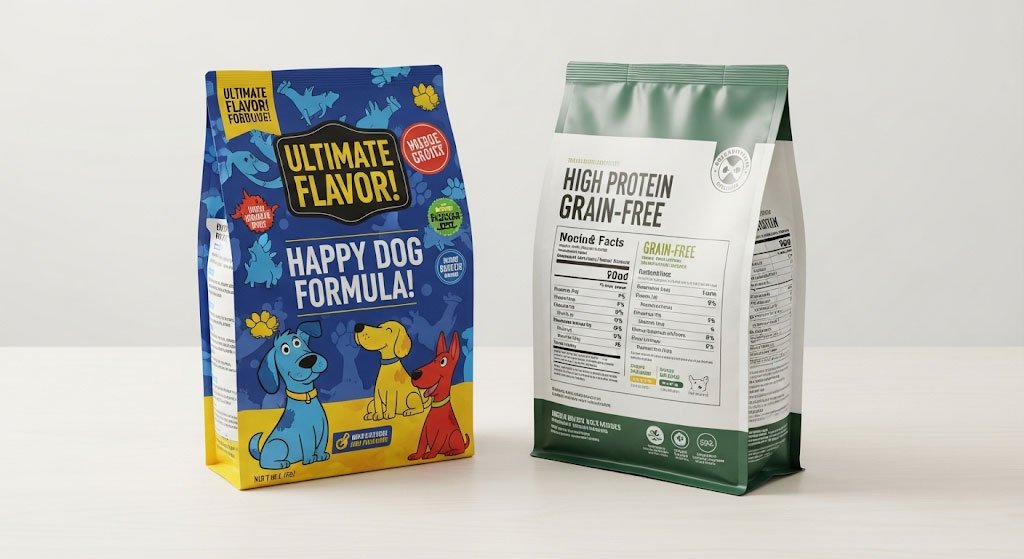Pet Health Care Guide: Ultimate Guide to Reading Dog Food Labels & Choosing Healthy Ingredients for Your Pet

Introduction to Dog Food Labels
Understanding dog food labels is essential for every pet owner aiming to provide the best possible nutrition for their furry companions. The ingredients listed on dog food packaging can significantly impact a dog’s health, affecting everything from its coat condition to energy levels, and even long-term wellness. A thorough comprehension of these labels allows owners to make informed decisions about what they feed their pets, ultimately influencing their overall health and quality of life.
This pet health care guide aims to equip pet owners with the necessary tools to decode dog food labels effectively. By becoming adept at reading these labels, pet owners can identify which products offer quality nutrition as well as those that may contain fillers or unhealthy ingredients. Awareness of what to look for will facilitate healthier eating habits for dogs, enabling owners to select the best dog food for pet health.
A common point of confusion arises from the variety of terms used in the industry. Some labels may prominently feature specific ingredients that seem appealing, while others might obscure less desirable components behind technical jargon. Therefore, understanding pet food labels extends beyond recognizing ingredients; it also involves knowing the nutritional value these ingredients provide and how they contribute to a dog’s overall diet.
Understanding the Ingredients List
The ingredients list on dog food labels is a crucial component in the pet health care guide, as it provides insights into the nutritional quality of the food offered. Ingredients are typically listed in descending order by weight, meaning that the first few ingredients often constitute the majority of the product. Therefore, when evaluating dog food, it is essential to scrutinize these initial items, as they greatly impact overall dog health.
One common point of confusion arises from the terms used in ingredient lists. For instance, “by-products” refer to parts of animals that may not be classified as muscle meat, such as organs or bones. While some animal by-products can be nutrient-rich, the quality can vary significantly, which is why looking for specific sources of protein, such as “chicken” rather than “chicken by-products,” is advisable. This distinction is vital in the context of a dog food ingredients guide, as higher-quality options can contribute positively to a dog’s health.
Another element worth noting is the presence of fillers such as corn, wheat, and soy. While these ingredients might serve as inexpensive sources of calories, they often lack vital nutrients necessary for a balanced diet. As part of understanding pet food labels, it is prudent to prioritize dog foods that feature high-quality whole ingredients. This can include specific meats, fish, vegetables, and grains.
When examining an ingredient list, look for recognizable ingredients and avoid artificial preservatives and fillers. Focusing on whole foods not only supports your dog’s overall health but also aligns with how to choose healthy dog food effectively. Identifying high-quality ingredients that meet your pet’s specific needs can lead to better health outcomes in the long run.
Deciphering Nutritional Adequacy Statements
Nutritional adequacy statements are key components found on pet food labels that indicate the food’s compliance with specific dietary standards. These statements are essential for pet owners seeking guidance on how to choose healthy dog food that meets their pets’ needs. The Association of American Feed Control Officials (AAFCO) provides guidelines that many manufacturers follow to ensure that their products meet the nutritional requirements of dogs. When evaluating a dog food product, look for AAFCO statements that specify whether the food is formulated for growth, maintenance, or special dietary needs.
There are generally two types of nutritional adequacy statements: “formulated to meet AAFCO standards” and “approved through feeding trials”. The first type indicates that the food is designed based on calculated dietary analysis to meet the requisite nutrient profiles. The second type means that the food has gone through actual feeding trials where it has been tested on dogs to determine if it fulfills their nutritional needs effectively. This distinction is important for pet owners who might want assurance regarding the best dog food for pet health.

When reading these labels, it is crucial to consider your dog’s age, breed, size, and activity level. Puppies, adult dogs, and senior dogs have different nutritional requirements that should be taken into account when interpreting nutritional adequacy statements. Furthermore, the implications of these statements extend beyond mere compliance; they can influence how well your pet maintains a healthy weight and overall well-being. Thus, understanding pet food labels is vital in making informed decisions to foster optimal health for your canine companion.
Analyzing Guaranteed Analysis
The Guaranteed Analysis section of dog food labels serves as a foundational element in understanding pet health care guide principles, specifically regarding nutritional content. This section provides a summary of minimum percentages for vital nutrients such as protein, fat, fiber, and moisture. By examining these figures, pet owners can make informed decisions about the healthfulness of the food they select for their dogs.
First and foremost, it is crucial to comprehend the significance of each nutrient. Protein is essential for building and repairing tissues, supporting immune function, and promoting overall growth. The Guaranteed Analysis will typically denote the minimum level of protein, often expressed as a percentage. A higher protein percentage usually indicates a meat-rich formulation, which can be beneficial for maintaining muscle mass and energy levels in active dogs.
Similarly, the fat content presented in the analysis indicates the caloric density of the food. Fats serve as a concentrated source of energy and contribute to the absorption of fat-soluble vitamins. While some pet owners may be concerned about fat leading to obesity, it is vital to recognize that healthy fats are a crucial element of a balanced diet, especially in active breeds. Look for dog food ingredients that specify healthy fat sources like fish oil or chicken fat in conjunction with responsible fat percentages.
Crude fiber is another critical component found in most dog food labels, representing the minimum amount of indigestible plant material. While fiber does not provide energy, it aids in digestion and helps maintain a healthy weight by promoting satiety. The moisture content, often significant in wet or canned foods, is equally important as it contributes to hydration and overall digestion. Understanding these elements will empower pet owners to choose suitable options in line with the best dog food for pet health criteria.
Ultimately, a thorough analysis of the Guaranteed Analysis allows for better-informed decisions about how to choose healthy dog food that meets the specific needs of every animal. By interpreting these percentages precociously, pet owners can ensure that their dogs receive the right balance of nutrients for optimum health and well-being.
Interpreting Caloric Content
Understanding the caloric content of dog food is crucial for maintaining optimal pet health. Dogs, much like humans, require a specific amount of energy to thrive, which largely depends on their size, breed, age, and activity levels. When examining a pet health care guide or selecting food options, attention to caloric content becomes paramount in ensuring that your dog receives the appropriate amount of nutrition.
The caloric requirement varies, but a general guideline is as follows: active dogs will require more calories compared to sedentary ones. For instance, a working dog that engages in intensive physical activity daily may necessitate around 30 calories per pound of body weight, while a more relaxed pet could need less than 20 calories per pound. It’s vital to assess your dog’s lifestyle and needs to determine suitable food. A good dog food ingredients guide will often provide caloric density on the package, which can help pet owners decide on appropriate portions and prevent overfeeding or underfeeding.

When reading the caloric content listed on dog food labels, be aware that these figures are usually given per cup or kilogram of the product. To facilitate your understanding, ensure you convert these values if necessary, depending on your measurement system. Additionally, understanding pet food labels may also highlight the proportion of calories derived from proteins, fats, and carbohydrates, which plays a significant role in meeting your dog’s overall energy requirements.
In choosing the best dog food for pet health, remember that a well-balanced diet should provide adequate energy without leading to obesity. By assessing caloric content alongside your dog’s lifestyle, you can make more informed decisions on how to choose healthy dog food. Ultimately, a more effective understanding of caloric content ensures that you meet your dog’s energy needs, thereby supporting both their health and longevity.
Recognizing Artificial Additives and Preservatives
When selecting the best dog food for pet health, it is crucial to scrutinize the ingredient list for artificial additives and preservatives. These substances are commonly used to enhance flavor, improve appearance, or extend shelf life but can pose potential health risks to your canine companion. Some frequently encountered artificial additives include colors such as Blue 2, Red 40, and Yellow 5, which are primarily used to make the food visually appealing. However, these synthetic dyes have been linked to hyperactivity and allergic reactions in some dogs.
Another category of concern encompasses artificial flavors and preservatives like BHA, BHT, and ethoxyquin. These chemical compounds serve to prevent spoilage and maintain freshness, yet research has raised questions about their safety. For instance, BHA has been classified as a potential carcinogen, while BHT’s effects remain poorly understood, raising alarm among dog owners who prioritize pet health care.
To effectively navigate the complexities of dog food labels, it is imperative to be vigilant. Understanding pet food labels can empower you to make informed choices. Look for dog food products that proudly advertise “no artificial additives” or “all-natural ingredients.” Natural preservatives such as tocopherols (Vitamin E) or ascorbic acid (Vitamin C) are preferable alternatives that do not compromise your dog’s health.
Additionally, incorporating a dog food ingredients guide can further assist in the selection process. This guide often highlights what constitutes quality ingredients, allowing you to compare various brands. Take time to research, and understand how to choose healthy dog food that promotes your dog’s well-being, ensuring optimal nutrition devoid of harmful additives. Adopting these practices will lead to healthier choices for your pet and enhance their overall quality of life.
Common Health Claims on Dog Food Labels
When examining the landscape of dog food, it’s essential to understand common health claims that manufacturers prominently feature on packaging. Terms like ‘grain-free’, ‘high protein’, and ‘all-natural’ are frequently encountered, yet their implications can often be misleading. Understanding these claims helps pet owners navigate the nuances of dog food ingredients and ensure they select products that truly align with their pet’s health needs.
The term ‘grain-free’ typically suggests that the food does not contain any grains such as wheat, corn, or rice. Many pet owners opt for grain-free diets under the assumption that these formulations are healthier for their dogs, especially for those with grain sensitivities. However, it’s important to note that ‘grain-free’ does not automatically equate to ‘healthy’; some grain-free options may be high in unhealthy fillers like peas or potatoes that can lack nutritional value.
Another common claim is ‘high protein’. While protein is a fundamental part of a dog’s diet, the quality of the protein source is crucial. A label boasting ‘high protein’ may not specify whether the protein is derived from meat, plant-based sources, or meat by-products. Choosing dog food with high-quality protein sources, which can be verified through a comprehensive dog food ingredients guide, is essential for maintaining optimal pet health.
The claim ‘all-natural’ also appears frequently, suggesting that the food contains no artificial additives or preservatives. However, the term ‘natural’ is not regulated, leading to varying interpretations. Pet owners should be cautious and prefer products with well-defined ingredients lists, as an understanding of pet food labels will greatly aid in selecting the best dog food for pet health.
Ultimately, while such claims can provide insight, they should not be the sole factor in deciding what is best for your dog. It is vital to consider your dog’s specific dietary needs and to scrutinize the full ingredient list to ensure that it aligns with their health requirements.
Consulting with Your Veterinarian
When it comes to ensuring your dog’s health, consulting with a veterinarian is a crucial step. Since each dog has unique health needs and dietary requirements, seeking veterinary guidance on dog food choices is essential for promoting optimal pet health. Dogs may have specific health conditions such as allergies, obesity, or diabetes that necessitate a tailored approach to their nutrition. A veterinarian can provide you with a personalized pet health care guide that addresses these conditions and suggests suitable dog food options.
Generally, it is advisable to consult your veterinarian during the following circumstances: when you are considering a change in your dog’s diet, when you notice any health issues, or when your dog reaches different life stages. Understanding how to choose healthy dog food in these contexts becomes significantly easier with the insights that a veterinarian can offer. They can help in breaking down dog food ingredients, explaining how each contributes to your pet’s overall well-being, and clarifying any doubts regarding understanding pet food labels.

Regular consultations with your veterinarian contribute to maintaining your pet’s nutritional health. During these visits, you can discuss the best dog food for pet health, ensuring it aligns with your dog’s needs while also considering any age-related changes or health conditions. Moreover, veterinarians keep current with the latest research and developments in pet nutrition, allowing them to guide you on how to select food that provides balanced nutrition for your dog.
Ultimately, incorporating veterinary advice into your dog’s feeding regime can significantly enhance the life quality of your pet, making it a vital component of any pet health care guide.
Final Tips for Choosing the Right Dog Food
Selecting the appropriate dog food is a critical aspect of maintaining your pet’s health and well-being. To make informed choices, pet owners should be aware of how to read dog food labels effectively. The ingredients and nutritional information provided on these labels can significantly impact their dog’s health. Here are some practical tips to ensure you choose the right food for your beloved companion.
First and foremost, consider a trial and error approach when introducing a new dog food. Transitioning to a new diet should be done gradually over several days to avoid digestive issues. Start by mixing a small amount of the new food with the current one, gradually increasing the new food’s proportion while decreasing the old. During this period, closely monitor your dog’s health and behavior. Any changes in energy levels, coat condition, or digestion may indicate whether the new food is suitable.
Additionally, it’s essential to regularly review your dog’s health after changing their diet. Each dog is unique, and nutritional needs may evolve due to factors like age, breed, and activity level. Understanding the importance of pet health care guides can aid in assessing whether the new diet meets your dog’s requirements. Also, stay informed about pet nutrition trends and research. This knowledge can provide valuable insight into how to choose healthy dog food and what constitutes the best dog food for pet health.
Lastly, don’t hesitate to consult your veterinarian for personalized advice on choosing the right food. They can offer insights into understanding pet food labels and recommend brands tailored to your dog’s specific health needs. Employing these tips will empower you to make informed decisions, ensuring your pet receives the nutrition they deserve.




